
Nikolai Andreyevich Rimsky-Korsakov was a Russian composer, a member of the group of composers known as The Five. He was a master of orchestration. His best-known orchestral compositions—Capriccio Espagnol, the Russian Easter Festival Overture, and the symphonic suite Scheherazade—are staples of the classical music repertoire, along with suites and excerpts from some of his fifteen operas. Scheherazade is an example of his frequent use of fairy-tale and folk subjects.

The Five, also known as the Mighty Handful or The Mighty Five, were five prominent 19th-century Russian composers who worked together to create a distinct national style of classical music: Mily Balakirev, César Cui, Modest Mussorgsky, Nikolai Rimsky-Korsakov and Alexander Borodin. They lived in Saint Petersburg and collaborated from 1856 to 1870.

Mily Alexeyevich Balakirev was a Russian composer, pianist, and conductor known today primarily for his work promoting musical nationalism and his encouragement of more famous Russian composers, notably Pyotr Ilyich Tchaikovsky. He began his career as a pivotal figure, extending the fusion of traditional folk music and experimental classical music practices begun by composer Mikhail Glinka. In the process, Balakirev developed musical patterns that could express overt nationalistic feeling. After a nervous breakdown and consequent sabbatical, he returned to classical music but did not wield the same level of influence as before.
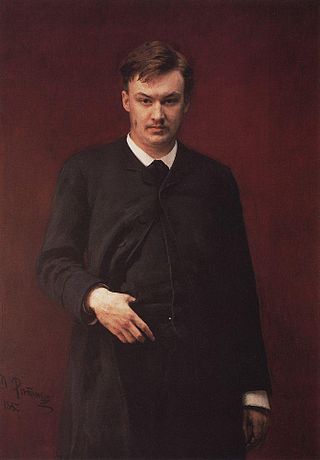
Alexander Konstantinovich Glazunov was a Russian composer, music teacher, and conductor of the late Russian Romantic period. He was director of the Saint Petersburg Conservatory between 1905 and 1928 and was instrumental in the reorganization of the institute into the Petrograd Conservatory, then the Leningrad Conservatory, following the Bolshevik Revolution. He continued as head of the Conservatory until 1930, though he had left the Soviet Union in 1928 and did not return. The best-known student under his tenure during the early Soviet years was Dmitri Shostakovich.
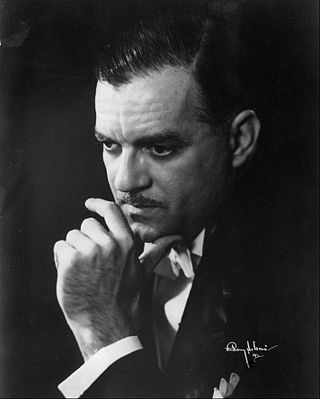
Jorge Bolet was a Cuban-born American concert pianist, conductor and teacher. Among his teachers were Leopold Godowsky, and Moriz Rosenthal – the latter an outstanding pupil of Franz Liszt.

Anton Stepanovich Arensky was a Russian composer of Romantic classical music, a pianist and a professor of music.
Islamey: Oriental Fantasy, is a composition for piano by Russian composer Mily Balakirev written in 1869. Harold C. Schonberg noted that Islamey was "at one time…considered the most difficult of all piano pieces and is still one of the knucklebusters." Its difficulty has led to the creation of numerous ossias and made it popular as a virtuosic showpiece.

Christian Georges Cziffra was a Hungarian-French virtuoso pianist and composer. He is considered to be one of the greatest virtuoso pianists of the twentieth century. Among his teachers was Ernő Dohnányi, a pupil of István Thoman, who was a favourite pupil of Franz Liszt.

Sergey Ivanovich Taneyev was a Russian composer, pianist, teacher of composition, music theorist and author.
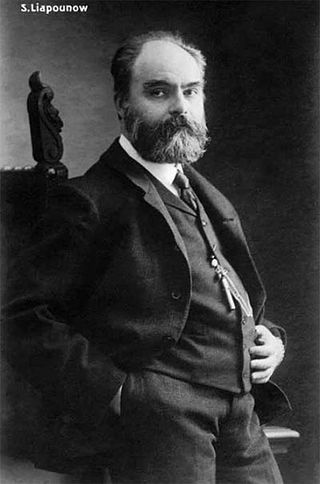
Sergei Mikhailovich Lyapunov was a Russian composer, pianist and conductor.

Eduard Francevič Naprávnik was a Czech conductor and composer. Nápravník settled in Russian Empire and is best known for his leading role in Russian musical life as the principal conductor of the Imperial Mariinsky Theatre in Saint Petersburg for many decades. In that capacity, he conducted the premieres of many operas by Russian composers, including those by Mussorgsky, Tchaikovsky and Rimsky-Korsakov.

Pyotr Ilyich Tchaikovsky's Piano Concerto No. 3 in E-flat major was at first conceived by him as a symphony in the same key. But he abandoned that idea, jetisoned all but the planned first movement, and reworked this in 1893 as a one-movement Allegro brillante for piano and orchestra. His last completed work, it was duly published as Opus 75 the next year, after he died, but given by publisher Jurgenson the title "Concerto No. 3 pour Piano avec accompagnement d'Orchestre".
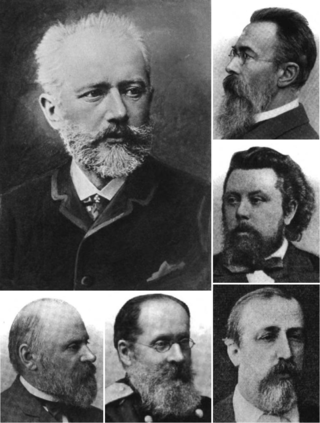
In mid- to late-19th-century Russia, Pyotr Ilyich Tchaikovsky and a group of composers known as The Five had differing opinions as to whether Russian classical music should be composed following Western or native practices. Tchaikovsky wanted to write professional compositions of such quality that they would stand up to Western scrutiny and thus transcend national barriers, yet remain distinctively Russian in melody, rhythm and other compositional characteristics. The Five, made up of composers Mily Balakirev, Alexander Borodin, César Cui, Modest Mussorgsky, and Nikolai Rimsky-Korsakov, sought to produce a specifically Russian kind of art music, rather than one that imitated older European music or relied on European-style conservatory training. While Tchaikovsky himself used folk songs in some of his works, for the most part he tried to follow Western practices of composition, especially in terms of tonality and tonal progression. Also, unlike Tchaikovsky, none of The Five were academically trained in composition; in fact, their leader, Balakirev, considered academicism a threat to musical imagination. Along with critic Vladimir Stasov, who supported The Five, Balakirev attacked relentlessly both the Saint Petersburg Conservatory, from which Tchaikovsky had graduated, and its founder Anton Rubinstein, orally and in print.

Antar is a composition for symphony orchestra in four movements by the Russian composer Nikolai Rimsky-Korsakov. He wrote the piece in 1868 but revised it in 1875 and 1891. He initially called the work his Symphony No. 2. He later reconsidered and called it a symphonic suite. It was first performed in March 1869 at a concert of the Russian Musical Society.

Nadezhda Nikolayevna Rimskaya-Korsakova was a Russian pianist and composer as well as the wife of composer Nikolai Rimsky-Korsakov. She was also the mother of Russian musicologist Andrey Rimsky-Korsakov.
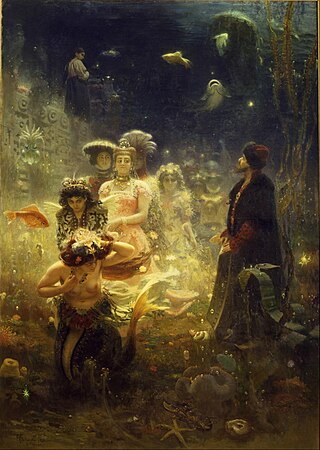
Sadko, Op. 5, is a Tableau musical, or Musical picture, by Nikolai Rimsky-Korsakov, written in 1867 and revised in 1869 and 1892. It is sometimes called the first symphonic poem written in Russia. It was first performed in 1867 at a concert of the Russian Musical Society (RMS), conducted by Mily Balakirev. Rimsky-Korsakov later wrote an opera of the same name which quotes freely from the earlier work. From the tone poem the composer quoted its most memorable passages in the opera, including the opening theme of the swelling sea, and other themes as leitmotifs – he himself set out to "utilize for this opera the material of my symphonic poem, and, in any event, to make use of its motives as leading motives for the opera".

Nikolai Rimsky-Korsakov composed his Symphony No. 1 in E minor, Op. 1, between 1861 and 1865 under the guidance of Mily Balakirev. Balakirev also premiered the work at a concert of the Free Music School in December 1865. Rimsky-Korsakov revised the work in 1884.
Alexander Glazunov wrote his Symphony No. 1 in E major, Op. 5, in 1881, when he was 16 years old. It was premiered the following year in St. Petersburg. It is known as his Slavonian Symphony.
Malcolm Binns is a British classical pianist.
















